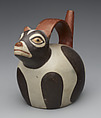Bottle in the shape of a dog
Modeled in the shape of a dog with details added with slip (a suspension of clay and pigments in water), this bottle was created by Nasca artists on Peru’s South Coast in the first centuries of the first millennium of the Common Era. Some dogs were likely family companions; others, such as hairless dogs, were thought to have healing properties. Some breeds, such as the one depicted here, may have helped families in farming or herding activities.
Dogs accompanied early human migrants across the Bering Strait to North America approximately 9900 years ago and spread rapidly throughout the hemisphere (Leathlobhair et al., 2018). Canine skeletal remains have been found in excavations at multiple sites in Peru including those from Moche, Pachacamac, Chiribaya, and Inca burials; the earliest dating from 1000 BCE (Brothwell et al., 1979). Several varieties of dogs existed and were important in both deer hunting and llama herding (Donnan and McClelland, 1999; Vásquez Sánchez, et al., 2009).
Nasca ceramicists were highly skilled. In many ways, the Nasca style is a continuation of the earlier Paracas style (see, for example, MMA 1974.123.1), but Nasca artists distinguished their work through the use of colorful slips applied before firing, thereby permanently fixing the color to the ceramic surface. A delicate sheen was achieved by burnishing the surface with a stone polisher or similar implement before firing, while the ceramic surface was still relatively moist.
Nasca artists depicted animals, plants, people, and supernatural beings in great detail, including distinctive hairstyles, nose ornaments, and elaborate clothing. These fine polychrome ceramics were used in ceremonies attended by hundreds of people, who transported these vessels back home as prestige items and as carriers of religious knowledge.
References and Further Reading
Donnan, Christopher B. and Donna McClelland, Moche Fineline Painting, Its Evolution and Its Artists. Fowler Museum of Cultural History, University of California, 1999, pp. 51, 70, 238, 242.
Ikehara-Tsukayama Hugo C., Dawn Kriss, and Joanne Pillsbury. Ikehara-Tsukayama Hugo C., Dawn Kriss, and Joanne Pillsbury. “Containing the Divine: Ancient Peruvian Pots.” The Metropolitan Museum of Art Bulletin Vol. 80, Number 4 (Spring 2023). “Containing the Divine: Ancient Peruvian Pots.” Metropolitan Museum of Art Bulletin vol. 80, no 4 (Spring 2023).
Lapiner, Alan C. Pre-Columbian Art of South America. New York: H. N. Abrams, 1976, p. 235.
Leathlobhair, Máire Ní et al., “The Evolutionary History of Dogs in the Americas.” Science. Jul 6; 361 (2018), pp. 81-85.
Pardo, Cecilia, and Peter Fux. Nasca. Lima: Museo de Arte Lima, 2017.
Vásquez Sánchez, Victor F., Teresa E. Rosales Tham, Gabriel Dorado Pérez. “Morphotypes and Breeds of Dogs.” Archaeobios, 1, (2009), pp. 20-33.
Vaughn, Kevin J. "Craft and the Materialization of Chiefly Power in Nasca," in Foundations of Power in the Prehispanic Andes, edited by Kevin J. Vaughn, Dennis Ogburn, and Christina A. Conlee. Archaeological Papers of the American Anthropological Association, No. 14, pp. 113-30. American Anthropological Association, 2005.
Wylde, Michael. The Inca Dogs and Their Ancestors. PhD dissertation, University of Florida, 2017.
This image cannot be enlarged, viewed at full screen, or downloaded.
This artwork is meant to be viewed from right to left. Scroll left to view more.



